History of street lighting in the United States
Street lighting in the United States was introduced to the US by inventor Benjamin Franklin, who was the postmaster of Philadelphia, Pennsylvania. For this reason, many regard Philadelphia as the birthplace of street lighting in the US.
The colonial-era streetlights were lit by candles placed inside a glass vessel, which kept the candle from being blown out by wind. Franklin's design was four-sided, with four separate panes of glass, so that if one pane of glass was broken, the lamp did not need to be entirely replaced, and might not even blow out.
After the invention of gas lighting by William Murdoch in 1792, cities in Britain began to light their streets using gas. The United States followed suit shortly afterwards with the introduction of gas lighting to Pelham Street in Newport, Rhode Island, in 1803.[1] Throughout the 19th century, the use of gas lighting increased. Some locations in the US still use gas lights.
After Thomas Edison pioneered electric use, light bulbs were developed for the streetlights as well. The first city in the United States to successfully demonstrate electric lighting was Cleveland, Ohio, with twelve electric lights around the Public Square road system on 29 April 1879.[2]Charles F. Brush of Cleveland, Ohio wanted to publicly test his new invention the "Brush light" and needed a city to do so. The city council of Wabash, Indiana agreed to testing the lights and on March 31, 1880, Wabash became the "First Electrically Lighted City in the World" as a flood of light engulfed the town from four Brush lights mounted atop the courthouse. One of the original Brush lights is on display at the Wabash County Courthouse.[3] By the beginning of the 20th century, the number of fire-based streetlights was dwindling as developers were searching for safer and more effective ways to illuminate their streets. Fluorescent and incandescent lights became popular during the 1930s and 1940s, when automobile travel began to flourish. A street with lights was referred to as a white way during the early 20th century. Part of New York City's Broadway was nicknamed the Great White Way due to the massive number of electric lights used on theater marquees lining the street.
Manufacturers
The two main manufacturers in the American street lighting industry during the 1950s were General Electric and Westinghouse. During this era, the most common lanterns in the local street lighting industry were Form 109 and later, Form 400 made by General Electric, and OV-20 made by Westinghouse.
In 1957, a new breed of streetlight fixture was introduced; the "cobraheads". If viewed from beneath they resembled a cobra's flared neck. Westinghouse dubbed its cobraheads the Silverliners, which remained in production over the next 25 years. The first model, the OV-25, is still a common streetlight fixture in many roads in North America.
GE later introduced its own cobrahead, called the M400. The original M400 is noted for its pointed front end that protrudes over its bowl-shaped diffuser (also called a refractor). The M400 was the OV-25's main rival. They carried 250–400 watt bulbs and were common on Interstate highways and city boulevards. GE made the M250 which was exactly same design as the M400 but using plastic refractor made for 250 watt. The M250 production ended in 1960 replacing with a M250R.
In 1964, Westinghouse produced an updated version of the OV-25, with a more rounded look. Only the diffuser was left unchanged.
In 1967, GE updated its M400 and M250 with its PowrDoor design, in which two separate doors, one for the lamp, and one for the gear were used, rather than one door for both. Gone was the protruding front end, and the new M400A and M250A were also more streamlined (although the original M400 and M250R continued to be produced until 1970). In 1970, a split-door M400 was introduced that shared the M400A's bodyshell but had a nonvented door held in place with a spring latch, while the M400A's vented door was held in place with a bail latch.
GE and Westinghouse also developed smaller fixtures. A small version of the M400 was made for suburban residential streets and alleys. That fixture was called the M250R which replaced the M250 which looked exactly like the M400 but with plastic lens and rated for 250 watt. In the same vein, Westinghouse offered three smaller Silverliners. The OV-12 (whose look resembles a miniature OV-50) came out in 1960, and it became the companion model to the Canadian-market OV-14B, which had been introduced in 1957. The OV-14B looks like a smaller version of the 1957-edition OV-25. Both the OV-12 and OV-14B were replaced by the OV-15 in 1965. These smaller fixtures carried 100–250 watt light bulbs.
The second-generation M400 and M250 were the first fixtures to sport the new high pressure sodium (HPS) lights that came out in 1966. The existing Silverliners could not handle these new lights, so Westinghouse developed a new OV-25, as well as a new OV-15. Both of these new Silverliners (also known as TuDors, and were similar to GE's popular PowrDoor series described above) now had a flat bottom, and weren't nearly as popular as the originals. However, by 1975, all Silverliners, including the single-door OV-15 and OV-25, were available as HPS units.
More new manufacturers entered the streetlighting industry. ITT (also known as American Electric, or ITT/American Electric) developed two new fixtures, the Model 13 and Model 25. The Model 25 was later the basis for a larger lookalike, the Model 327. All three fixtures had a boxy look that usually sported grinning diffusers, a nod to the OV-15s and M250s. (Of the three fixtures, only the Model 327 is still in production.)
The Model 327, along with GE's M1000 and Westinghouse's OV-50, sported 700–1000 watt lights (see table).
Earlier versions of the M1000 and OV-50 (and, in very rare instances, the Model 327) are noted for having fins on top of the fixture. As newer ones were made, the fins were eliminated.
Some well-known light fixtures came from the Line Material Company. In the 1960s, during the height of the mercury lights' popularity, Line Material produced the Unistyle 400 and the smaller Unistyle 175. Both of these fixtures combined various characteristics of the Silverliners and GE M-series fixtures. When the sodium era began around 1970, the company (by then, renamed McGraw-Edison) produced the boxy, rectilinear, more simplified Unidoor 400 (for metropolitan expressways and city boulevards) and Unidoor 175 (for smaller residential streets and alleys).
In 1982, the entire Silverliner line was discontinued, when Cooper Lighting bought Westinghouse's streetlighting division, and rebranded them as Crouse-Hinds models (with the OV-15 and OV-25 becoming the L150 and L250, respectively). Today, Cooper still makes the OV-50, now called the OVL. It also continues to manufacture the OV-15 and OV-25 models for sale in Canada. Other popular Cooper/Crouse-Hinds luminaires include the OVM (which replaced the L250 in 1985), OVS (which replaced the L150 in 1985), OVX (which was introduced in 1994 and covered all wattages from 35 to 400 watts), OVZ (which replaced the OVS in 1995, and has a Canadian counterpart called the OVC), OVD/OVF/OVY (the current midsized fixtures, introduced in 1998) and OVG/OVH (the current small fixtures, introduced in 1998).
GE and Cooper continued to take streetlighting to new heights. GE was a pioneer in the full-cutoff arena, when it created a spinoff of the popular M400 and the rarer M250 in 1975. This fixture is noted for its pointed front end and lack of a diffuser. In addition, high-mast assemblies were developed for the light towers that were springing up along Interstate highways.
In 1988, ITT/American Electric also created spinoffs of its Model 13 and 25. These new fixtures, called the 113 and 125, had a more-rounded look than their respective predecessors. While the Model 125 continues production today, the Model 113 was replaced by the Model 115 in 2003. In 1992, ITT sold American Electric to Thomas & Betts. In 2001, Thomas & Betts sold the street lighting division to Acuity Brands, where it was then spun off as American Electric Lighting. Additionally, ITT/American Electric also had its own power-door luminaires (carrying the Power Pad Door name), which were called the Models 313 and 325, with the former one being replaced by the Model 315 in 2003, and the latter continuing to be produced.
In 1986, GE revamped its entire lineup. One, called the M400R2, had a flat bottom reminiscent of the third-generation Silverliners and once again used a single door; the other, now called the M400A2, retained the original 1967 design but no longer had the vented door that the previous model did. Also, the M250R2 featured a slightly flatter profile than the M250R it replaced, and the M250A2 now took on the boxy profile that was previously used by the M150, which had been introduced in 1980. In 1997, the M400/M400A underwent a total redesign, borrowing its styling from the Thomas & Betts Model 125/325. In 2008, GE resumed production of the M400A2 and M400R2, which were sold concurrently with the 1997-edition M400 and M400A models until 2016.
In addition to the 1997 M400s and M400As, there have been many instances of manufacturers copying off another maker's luminaires to create their own: For example, the Hubbell RLG400 has a look that closely resembles the ITT/American Electric Model 25, and ARK Lighting has two distinct fixtures that reuse the designs of the M250As and M250A2s (with the first example made to use 400 watt lamps, which the actual M250 series has never been equipped to handle).
More recently, teardrop lamps (both existing and reproductions) have been used in favor of cobraheads in both urban and suburban areas. They are usually complemented with bishop's crook poles and more elaborate architectural elements. King Luminaire (a division of the StressCrete Group) manufactures these.
In addition to the existing manufacturers, newcomers such as Leotek have begun to make LED cobrahead luminaires to replace those that have used MV or HPS lamps. Cree have also become one of the most popular brands for LED lighting. GE's LED fixtures are sold under the Evolve banner.
Electric light generation methods
Arc lamp
Open Arc lamps were used in the late 19th and early 20th century by many large cities for street lighting. Their bright light required that the early arc lamps be placed on rather high (60 to 150-foot) towers; as such, they might be considered the predecessor to today's high-mast lighting systems seen along major highways. They were also widely used in film and stage. Arc lamps use high current between two electrodes (typically carbon rods) and require substantial maintenance. Arc lights have mainly been used where high lumen light was needed such as lighthouses. Today very few open arc lights remain in operation, primarily in a few lighthouses and some industrial uses. The only remaining examples of original street lighting use are the moonlight tower of Austin, Texas.
A xenon lamp is a high pressure sealed arc lamp, and is in common usage today where extreme brightness in a relatively small space is required, typically in motion picture projectors in theaters, and stage and motion picture lighting. They are also found in car headlamps. The sealed arc lamps do not suffer from the inefficiency and high maintenance problems of the original open arc lamps, but they are not well suited for most street lighting use.
Incandescent light
Incandescent lights using a tungsten filament were the first low power electric lights in cities worldwide and introduced some 20 years after open arc lamps. Some can still be found in streetlight service. Others have been installed in popular downtown areas of major cities to have a nostalgia effect. Incandescent light has excellent Color rendering index rated at 100. Color temperature is generally around 2000–3200 K depending on the type of lamp and replaced the higher maintenance arc lamps.
An incandescent light bulb is less efficient when compared to High-intensity discharge lamp and gas discharge lighting such as Neon light and are being replaced by more efficient compact fluorescent lamps or converted to mains voltage or high pressure sodium lamps. Tungsten-halogen incandescent lights which are brighter and more efficient and are very commonly used in theatrical and motion picture lighting and better color temperature characteristics are little used in street lighting due to their relatively short lifespan.
Standard incandescent lamps are very commonly used in traffic signals, although they are increasingly replaced by LEDs.
Fluorescent lamp
The fluorescent lamp first became common in the late 1930s. These lamps are a form of discharge lamp where a small current causes a gas in the tube to glow. The typical glow is strong in ultraviolet but weak in visible light. The glass envelope is coated in a mixture of phosphors that are excited by the ultraviolet light and emit visible light. Fluorescent lamps are much more efficient than incandescent lamps, and for a short time became popular in street lighting both because of the efficiency and the novelty value. Fluorescent lamps for street lighting were first introduced to the public for commercial uses at the 1939 World's Fair.
The major problems with standard fluorescent lamps for street lighting is that they are large, and produce a diffused non-directional light. They are also rather fragile. Therefore, the fixtures needed to be large, and could not be mounted more than 20–30 feet above the pavement if they were to produce an acceptable light level.
Fluorescent lamps quickly fell out of favor for main street lighting, but remained popular for parking lot and outside building illumination for roadside establishments.
Mercury vapor

In 1948, the first regular production mercury vapor (MV) streetlight assembly was developed. It was deemed a major improvement over the incandescent light bulb, and shone much brighter than incandescent or fluorescent lights. Initially people disliked them because their bluish-green light made people look like they had the blood drained from them. Other disadvantages are that a significant portion of their light output is ultraviolet, and they "depreciate"; that is, they get steadily dimmer and dimmer with age while using the same amount of energy, and in a few rare instances, they also cycle at the end of their life cycles. Even rarer is they can burn out, especially when the light is being burned while dim (usually at the end of the life cycle). Mercury lamps developed in the mid-1960s were coated with a special material made of phosphors inside the bulb to help correct the lack of orange/red light from mercury vapor lamps (increasing the color rendering index(CRI)). The UV light excites the phosphor, producing a more "white" light. These are known as "color corrected" lamps. Most go by the deluxe (DX) designation on the lamp and have a white appearance to the bulb. Mercury Vapor Bulbs come in either clear or coated with powers of 50, 75, 100, 175, 250, 400, 700 or 1,000 Watts. The Mercury Vapor lamp is considered obsolete by today's standards and many places are taking them out of service.
As of 2008, the sale of new mercury vapor streetlights and ballasts was banned in the US by the Energy Policy Act of 2005, although the sale of new bulbs for existing fixtures does continue, but the bulbs were also banned in 2015 in Europe. Mercury vapor fixtures can be operated with metal halide lamp (MH) ballasts, and are likely to be rewired with these ballasts in coming years. In response to the ban, some older MV streetlights will most likely be modified to use either high pressure sodium or metal halide lamps in the near future, because they are known to last longer than newer luminaires. In some areas where the MV lights are either failing or being replaced, they are being replaced by either HPS, LED, or Induction fixtures of similar lumen output, but also lower wattages and power consumption as well.
High pressure sodium

Around 1970, a new lamp was invented: The high pressure sodium (HPS) light. They became common in the late 1980s. It was initially disliked by most residents because of its orange glow, but the sodium vapor streetlight has since become the dominant type on American roadways and most people have become accustomed to the orange/yellow glow. Color-corrected sodium vapor lamps exist but are expensive. These "color corrected" HPS lamps have lower life and are less efficient.
There are two types of sodium vapor streetlights: high-pressure (HPS) and low-pressure (LPS). Of the two, HPS is the more-commonly used type, and it is found in many new streetlight fixtures. Sometimes, older (pre-1970) fixtures may be retrofitted to use HPS lights as well. Virtually all fixtures that are converted to HPS have previously been lit with mercury vapor.
LPS lights are even more efficient than HPS, but produce only a single wavelength of yellow light, resulting in a CRI of zero, meaning colors cannot be differentiated. LPS lamp tubes are also significantly longer with a less intense light output than HPS tubes, so they are suited for low mounting height applications, such as under bridge decks and inside tunnels, where the limited light control is less of a liability and the glare of an intense HPS lamp could be objectionable. Many LPS lights are also being changed out to HPS using FCO fixtures, or going to LED.
HPS lamps have slightly different electrical requirements than do the older MV lamps. Both HPS and MV lamps require a transformer or ballast to change the voltage and regulate the current, however, HPS lamps also require an electrical "starter" circuit—much like older fluorescent lamps in residential use. MV lamps do not require a separate "starter" circuit because they have a special starter element within the bulb used for striking the arc. MV lamps slowly dim over time, and a 20-year-old lamp may emit a very pleasing, but useless, soft green glow, rather than the powerful blue-white light of a new MV lamp. The yellow-spectrum HPS lamps also slowly dim over time but are known for "cycling," where the lamp cycles on and off when it has reached the end of its life cycle. When cycling, the arc within the lamp extinguishes and the lamp must cool down before the starter circuit initializes a new arc. This has been the most recognized downfall of HPS. Some HPS lamps start to burn a pinkish/reddish color at the end of their life (usually when already cycling), or start to burn a pinkish/white color and go dim, or also burn out at the end of their life cycle whether they cycle or not. HPS fixtures can contain a special photocell or ballast that can sense a cycling lamp and shut off the fixture to prevent damage to the ignitor and ballast.
HPS lamps generally have the same rated lifespan as MV lamps, and they give increased light and efficiency at lower wattages. Usually, when an MV light is replaced, it is replaced with a HPS light of a lower wattage, for example, a 175 watt MV fixture will get replaced with a 100 or 150 watt HPS fixture as that will meet or exceed the lumen output of the 175 watt MV fixture. At end of life MV lamps just become dimmer and sometimes color shift towards the green end of the spectrum but continue to consume the same amount of electricity. HPS lamps begin to suffer end-of-life cycling before the amount of useful light becomes visibly diminished, or just burn out. HPS lights come in wattages of 35, 50, 70, 100, 150, 200, 250, 310, 400, 600, 750, and 1,000 watt sizes, while LPS lights come in wattages of 18, 35, 55, 90, 135, and 180 watt sizes.
Although the use of HPS is dramatically decreasing in many large cities, it is still a popular form of use in grow lights, as seen in greenhouses, aquariums and planetariums.
Metal halide
In recent years, metal halide lamp (MH) streetlights have illuminated roadways and parking lots. Metal halide has long been popular in business installations and can be found in warehouses, schools, hospitals and office buildings. Unlike the old mercury lights, metal halide casts a true white light. It is not nearly as popular as its sodium counterparts, as it is newer and less efficient than sodium.
Metal halide lights have also been used for retrofitting. Virtually all fixtures that are converted to metal halide have previously been lit with high-pressure sodium (HPS). MH lamps suffer color shift as they age though this has been improving. Actual life expectancy is about 10,000 to 12,000 hours on average. There has also been a noted issue with the lamps "exploding/shattering" during a failure. Metal Halide light bulbs also tend to dim and/or flicker at the end of their life cycles, and on occasion, cycle. Sometimes, they emit a pinkish glow at or near the end of their life cycle which in this case, the bulb just burns out. High cost and low life hours has kept them from becoming popular municipal lighting sources even though they have a much improved CRI around 85. Therefore, the use of metal halide is limited mainly to city and high end street lighting. They are available in clear or coated bulbs. Probe start MH lights (which are less efficient and are also soon to be banned, unlike Mercury Vapor lamps) come in wattages of 50, 70, 100, 175, 250, 400, and 1000 watt sizes, while pulse start MH lights come in sizes of 50, 70, 100, 150, 200, 250, 320, 350, 400, 450, 750, and 1,000 watt sizes. The wattages of pulse start metal halide lamps are similar to HPS lamp wattages.
Ceramic discharge metal halide lamp
Ceramic discharge metal halide lamps promised to be the next step in streetlighting, replacing old mercury vapor and high pressure sodium lamps, especially where a more clear white with better CRI (78–96) and light color retention was desired. Ceramic metal halide lamps give five times more light than comparable tungsten incandescent light bulbs (80–117 lm/W). However, continuing refinements in LED technology have now surpassed most other lighting types.
Induction lamp
An induction lamp features extremely long lamp life (100,000 hours), energy efficiency, high color rendering index, and a color temperature close to incandescent lights. The life of induction (also known as electrodeless fluorescent) lamps is negatively affected by heat, particularly as the temperature exceeds 35 degrees Celsius (95 degrees Fahrenheit). Since temperatures in this range commonly occur during early night hours in the summer in much of the US, induction lamp applications have not extended beyond test and demonstration projects for street lighting. The larger size of the induction lamps also inhibits the effective control of the light they emit, limiting their use to lower mounting applications. In 2009, PSEG in New Jersey began using induction lighting from US Lighting Tech, Inc (Irvine, CA) to replace very old and even some pre-2008 mercury vapor lights, and have had success in their reliability and output of the fixtures. Unfortunately, some failed induction lights were spot replaced with the HPS lights that were being removed to begin with and many new installs, PSEG is still using HPS. An updated design of the induction lights is now being used and these seem more reliable and brighter than the original design. Beginning in September 2011 the City of San Diego, CA will replace some 35,000 street lights with induction lamps costing $16,000,000.00.[4] In Mexico, the city of Linares and Acapulco also have begun the replacement of 6,500 and 42,000 street lights with induction lamps from Amko SOLARA Lighting (Taipei, Taiwan), selected for their smart controls, since October 2011. A portion of these street lights from Amko will feature smart grid compatibility to allow the lights to be remotely monitored and controlled via the Internet.[5][6]
Compact fluorescent lamp
Compact fluorescent lamps (CFL) have been used more frequently as time has improved the quality of these lamps. These lamps have been used on municipal walkways and street lighting though they are still rare at this time. Improvements in reliability still need to be made. Some issues with them are limited lumen output, high heat build up in the self-contained ballast, low life/burnout due to frequent cycling (on/off) of the lamp, and the problem where most fluorescent sources become dimmer in cold weather (or fail to start at all). CFL efficiency is high and CRI is excellent around 85. CFL produces a color temperature around 3000 K with its light being "soft white" around that color temperature. Higher color temperatures are available.
Light emitting diodes

Light emitting diodes (LED) have virtually replaced both incandescent lamps and the occasional fluorescent lamp in traffic signal and crossing sign usage. They are rapidly developing in light output, color rendering, efficiency, and reliability. The cost of LED lighting is still high compared to an incandescent or arc-discharge lamp used for the same purpose, but the cost is decreasing rapidly. Even with the high per-unit cost, the increase in efficiency and increased lifespan make them very attractive for street lighting use. The reduced cost of electricity and maintenance in some cases can offset the increased cost of the lamp.
LEDs are increasingly finding widespread usage in general street, sidewalk, or parking lot illumination as technology improvements bring their brightness and cost into competition with HPS, MH, or CFL lighting. For example, the city of Ann Arbor, Michigan, implemented LEDs in street lighting applications in March 2006 and have since expanded their use.[7] In addition Chapel Hill, North Carolina, entered a 12-month test program and partnership with Duke Energy on March 25, 2009, to evaluate the effectiveness of replacing existing HPS lighting with the more efficient LED street lighting within its vibrant downtown.[8] In late 2008, Anchorage Alaska installed over 4,000 LED streetlights as part of a plan to convert the community's 16,000 roadway lights to efficient white light. In mid-2009, the City of Los Angeles announced a 5-year project with the Clinton Climate Initiative to replace all 140,000 of the city's existing streetlights with LED fixtures.[9] In mid-2010, Seattle City Light began installing LED streetlights in a residential neighborhood as part of a plan to install 40,000 LED streetlights over the next 5 years.[10] Also, Atlantic City Electric in Southern NJ is also testing out LED streetlights made by 2 different manufacturers in 4 communities to evaluate if LED lights are worth using over HPS. As of late 2015, Atlantic City Electric has decided to go ahead and replace all utility owned or leased MV and HPS cobra head and floodlights with LED lighting, if the municipality is interested (which many are). The town of Stratford, NJ was the first town in their service territory to receive the new LED lights, with many more to follow. The parking lot at Camden County College in Blackwood, NJ is now using LED postlights that replaced the previous HPS flood and shoebox lights. The Cities of Philadelphia and New York have also begun testing LED streetlights and Philadelphia is now in the process of changing existing HPS lampost lights from HPS to LED and all new installs are LED. Philadelphia is also conducting a study to see if it will be feasible to replace all city owned street lights with LED by 2018 (about 60,000 lights) and many areas of the city already have them; other major cities, such as Baltimore and Charlotte, have already begun to replace their HPS lights with new LEDs in different sizes. The town of Abington, PA has installed LED streetlights on their main and secondary streets to replace MV fixtures. In spring of 2011, the municipally-owned energy provider for San Antonio, Texas, CPS Energy, entered into contract with GreenStar LED (of Boerne, Texas) for an order of over 25,000 LED street light fixtures. LED street light have been introduced also in smaller cities and communities, for example, in Brisbane, CA.
As with other semiconductors, heat buildup in an LED dramatically reduces its life. The temperature at which this reduction in life occurs is often very near summer evening ambient temperatures. Many of the heat-removal technologies used for other semiconductor applications, such as air conditioning systems, fans, or thermal-transfer fluids, are impractical, maintenance-intensive, or cost-prohibitive for street lighting. Airborne dust from industrial and agricultural activities can impair the functioning of finned heat sinks. Achieving good maintenance-free thermal management in an often hostile environment while keeping product cost competitive is the largest hurdle to the widespread adoption of LED street lights.
Optical types
- Non-cutoff
- The non-cutoff fixtures usually include the globe-shaped lamps that are mounted atop lampposts. These lamps distribute light in all directions. A major problem is created by the light pollution and glare, as they shoot their light upwards into trees and towards the sky rather than towards the ground. Non-cutoff fixtures are rarely found on roadways because they tend to blind the driver.
- Semicutoff
- This is the most common street lighting optic. The semicutoff fixtures usually refer to the cobraheads, but they can also apply to some lamppost-mounted fixtures that do not emit their light upwards. Most of the light can be emitted below 90 degrees, but as much as 5% of the light can also be emitted above 90 degrees. These fixtures do a good job of spreading the light towards the ground but some uplight is possible, though not as serious as non-cutoff fixtures. Semicutoff fixtures are often mounted on tall poles.
- Cutoff
- These optics give more light control than semicutoffs. Less than 2.5% of the light can leave the fixture above 90 degrees. Cutoff fixtures have gained popularity in recent years, as they are available from manufacturers like GE and American Electric. The cutoff lights have a wider spread of light than full-cutoffs, and they generate less glare than semicutoffs. The cutoff lenses consist of a shallow curved glass (also called a sag lens) that is visible just below the lighting area on the fixture. As with the semicutoffs, these fixtures are very commonly seen with both mercury vapor and HPS lamps (and occasionally with metal halide as well).
- Full-cutoff
- These lights do not allow any of the light to escape the fixture above 90 degrees. Full-cutoffs distribute their light in a defined pattern, potentially providing more light on the ground at lower power consumption. In recent years, cutoff-type lights have gained popularity. Although full-cutoff fixtures generally use HPS lamps, some metal halide and even a few mercury vapor ones are known to exist, and recent LED fixtures use this optic as well.
Fixture type identification
Many streetlights are marked with a NEMA wattage label to aid workers in identifying them.
The system is as follows: The color of the sticker indicates the type of light, the number is one tenth of the power in watts. The higher the number, the brighter the light. Newer stickers also have small letters printed in the lower right corner to indicate the type of light that is used in the fixture.
There are three exceptions to this rule:
- A "17" sticker adds a five to the power rating, and therefore, the light is rated at 175 watts.
- If a sticker reads "X1," it describes a 1000-watt light.
- If a sticker reads "3," it describes a 35-watt light.
- Also MH stands for Probe Start Metal Halide, while PSMH stands for Pulse Start Metal halide.
Sticker colors:
- Purple: Incandescent lamps
- Blue: Mercury vapor lamps
- White: Light-emitting diode or older high pressure sodium lamps.
- Soft White or Colored: Compact fluorescent lamp
- Red: Metal halide (Probe start)
- Half Red/Half White: Metal halide (Pulse start) and some ceramic metal halide lamps
- Yellow: Older high and low pressure sodium lamps, induction lamps and some ceramic metal halide lamps
- Orange: new sticker color, now used for high pressure sodium lamps
Colors vary for new LED street lights such as black for Philips Hadco RX1 and RX2 or Green for BetaLED luminaires. The Induction fixtures usually contain a green and white sticker. Some CMH lights also use a yellow sticker as well as red/white. Some LED stickers have the full wattage on them (Example: it will read 50 LED, which identifies the fixture as a 50 watt LED fixture)
Frequently seen power ratings:
- "3" sticker - 35 watts (HPS/LPS)
- "4" sticker - 40 watts (Induction)
- "5" sticker - 50/55 watts (MV/HPS/LPS/PSMH/LED)
- "7" sticker - 70 watts (HPS/PSMH/MH/LED/Induction)
- "8" sticker - 80 watts (Induction)
- "9" sticker - 90 watts (LPS)
- "10" sticker - 100 watts (MV/MH/PSMH/HPS/Induction/LED)
- "11" sticker - 110 watts (LED)
- "13" sticker - 135 watts (LPS)
- "15" sticker - 150 watts (HPS/PSMH/Induction/LED)
- "17" sticker - 175/179 watts (MH/MV/LED)
- "18" sticker - 180/189 watts (LPS/LED)
- "20" sticker - 200 watts (HPS/PSMH/LED)
- "25" sticker - 250 watts (MV/PSMH/HPS/Induction/LED)
- "27" sticker - 270/274 watts (LED) or 100 watts (HPS)
- "28" sticker - 285 watts (LED)
- "31" sticker - 310 watts (HPS)
- "32" sticker - 320 watts (PSMH)
- "35" sticker - 350 watts (PSMH)
- "37" sticker - 37 watts (LED) - New: For BetaLED's luminaires in Boston, MA
- "39" sticker - 39 watts (LED) - New: For BetaLED's luminaires in Boston, MA
- "40" sticker - 400 watts (MV/PSMH/MH/HPS)
- "45" sticker - 450 watts (PSMH)
- "60" sticker - 600 watts (HPS)
- "70" sticker - 700 watts (MV)
- "70" sticker - 70 watts (LED)
- "75" sticker - 750 watts (HPS/MH/PSMH)
- "X1" sticker - 1000 watts (MV/HPS/MH/PSMH)
Notes
Note 1: Unistyle luminaires are known for their arched top and sloped front end, while their Unidoor successors have a boxy profile. The 175 designation is used for the smaller versions of both styles by most people, but some use the 250 designation, since they were capable of light sizes of up to 250 watts.
Note 2: Silverliner luminaires that have been rebuilt and painted light grey are referred to as "Greyliners"/"Grayliners." Usually, they include the single-door OV-15 and OV-25 Silverliners, and the OV-50 was also switched to a Greyliner scheme when Cooper Lighting bought out Westinghouse's streetlighting division in 1982. Its immediate successor, the Cooper OVL, is also considered to be a Greyliner. Although other Cooper/Crouse-Hinds luminaires, like the OVM/OVS and OVX/OVZ, use the grey color scheme, they are not referred to as Greyliners.
Note 3: It is also very common to reuse older luminaires with newer parts. The most common practice is retrofitting a normal MV luminaire to use HPS lamps. This is being done in most small towns and a few mid-sized cities because it is cheaper to rewire an existing fixture rather than buying completely new ones. Sometimes, normally silver luminaires, like the 1959-era GE M250s/M400s and Line-Material Unistyles/Unidoors, are repainted light grey; the most common examples of these are the aforementioned Westinghouse Greyliners.
Note 4: GE's revival of the M400A2 and M400R2 designs in 2008 is believed to be the first time ever that a manufacturer has resumed production of a previous design. Despite this, the newer 1997 "American Electric" designs also continue to be in production.
Note 5: During production of the Westinghouse OV-25, and to a certain extent, the OV-15 as well, Westinghouse utilized four different glass refractor designs during the series run. Three of which, used in the first generation ("flatbottom"), second generation, and third generation (this style is still used today for Cooper luminaires), were manufactured by Holophane, the other design, used for the second generation Silverliner, was manufactured by Corning Glass.
List of streetlight manufacturers and fixtures
| Fixture name (compatible wattages) | Notes
American Electric/ITT/Thomas & Betts/AEL | ||
|---|---|---|---|
Model 13-000 (50–250 watts)
 |
Same as the boxier, bulkier looking Model 13 that would follow, but had a similar shape of a Model 113 and had more of a Silverliner appearance. | ||
Model 25-000 (250–400 watts)
 |
Same as the boxier, bulkier looking Model 25 that would follow, but more of a Silverliner appearance. | ||
Model 17-000 (700–1000 watts)
 Found in Dedham, Massachusetts |
Same as the boxier, bulkier looking Model 327 that would follow, but more of a Silverliner appearance. | ||
Model 13 (50–250 watts)
 |
The smaller companion to the Model 25. A power pad version of this fixture was also available, and it was the immediate predecessor to the Model 313. | ||
Model 25 (200–400 watts)
 |
The larger companion to the Model 13, and later inspired an even larger version. | ||
Model 327 (700–1000 watts)
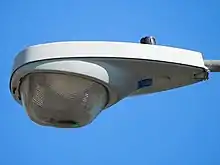 |
A spinoff of the Model 25, and as of this writing it is still in production as AEL's only 1 KW fixture. | ||
Model 113 (50–250 watts)
 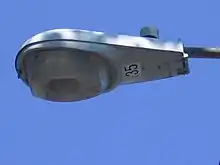 Rare 35 watt version found in Canton, Massachusetts  Rare 35 watt version found in Westwood, Massachusetts |
Replaced the Model 13. Has softer, more rounded lines than its predecessor. Its bodyshell resembles a more modernized version of the original Model 13. | ||
Model 213 (50–250 watts)
 |
Early version of the Model 313 PowerPad found near Alewife Station in Cambridge, MA. | ||
Model 313 (50–250 watts)
 |
The power pad version of the 113. | ||
Model 115 (50–400 watts)
 |
Replaced the Model 113. Introduced in 2003 by Acuity Brands Lighting /American Electric. | ||
Model 315 (50–400 watts)
 |
The power pad version of the 115. This small fixture, like the Model 115, Crouse-Hinds OVS and Cooper OVX, also has the option for medium-sized lamps (310-400 watt) often causing shorter lamp life and premature cycling) | ||
Model 125 (150–400 watts)
 |
Replaced the Model 25. Has softer, more rounded lines than its predecessor. GE's M400 has used this design since 1997, but with some noticeable differences: The 125 has a slightly smaller housing than the M400 and an internal latch, as evidenced by its indented front end. | ||
Model 325 (150–400 watts)
 |
The power pad version of the 125. | ||
| Model 245 (50–150 watts) | Contempo Post-Top Model, comes with A or D style hoods | ||
| Model 247 (50-150) | American Revolution Post-Top model. Formerly, the socket was situated on top of the ballast inside the fixture, now the lamp is in top in the hood. | ||
Model 413 (50–150 watts)
 |
The 413 was created for International customers so they could fit more fixtures per container. The 115 was redesigned so 40 cartons fit on a pallet, thus eliminating the need for the 413. | ||
Roadway-Area-SRP (50–110 watts)
 |
AEL's medium LPS fixture. | ||
Roadway-Area-SRX (35–90 watts)
 |
AEL's smaller LPS fixture. | ||
Roadway-Area-SP2 (90–180 watts)
 |
AEL's larger LPS fixture. | ||
Durastar 2000 (50–150 watts)
 |
A semi-cutoff or full-cutoff fixture, manufactured of fiberglass and uses unique Duralock docking station, the fixture is composed of two parts the docking station that contains the slipfitter, and the fixture, the fixture locks on to the mounting station. The durability of this fixture is frequently questioned, as is its design, as many has been replaced by other cobrahead or NEMA fixtures not made out of fiberglass. | ||
| Durastar 3000 (150–400 watts) | Same features as 2000 series, except this series is slightly longer to hold the larger ballasts of 400 watt fixtures. This version also has an internal latch as opposed to the external latch of the Durastar 2000. | ||
| Corvus CVM (70–250 watts) | Available in either Cutoff or Full Cutoff the Corvus CVM is a small sized cobra head that is slightly more decorative then most others. | ||
| Corvus CVL (100–400 watts) | Available in either Cutoff or Full Cutoff the Corvus CVl is a medium-sized cobra head that is slightly more decorative then most others. | ||
| series 245 | Contemporary post top lumanaire. | ||
| Series 247 | American Revolution post top lumanaire. | ||
| Series TWT | Contemporary TwistPack post top lumanaire. | ||
| Series 870/Series LSH | Federal (Acorn) post top lumanaire. | ||
| Series 11 | NEMA Head luminare. | ||
| LEDR (70–100 watts) | The LEDR was the first LED fixture manufactured by AEL, it was available in either 70 or 100 watts of LED. It was discontinued in 2011 for unknown reasons and replaced by the ATB1. | ||
LNH2
 |
LED fixture manufactured by AEL, found in Raynham & Taunton, Massachusetts. | ||
ATB0 (25-100 watts)
 |
LED luminaire introduced in 2013. First seen in Dedham, Massachusetts. | ||
ATB2 (100-215 watts)
  215 watt version found in Winthrop, Massachusetts  90 watt dayburner found in Boston, Massachusetts |
LED luminaire introduced in 2013. First seen in Dedham, Massachusetts. | ||
ATBS (20-100 watts)  |
Small LED lumanaire. Replaces 50-200 watts | ||
ATBM (50-150 watts) Day burner  |
Medium LED lumanaire. Replaces 250-400 watts | ||
ATBL (150-250 watts)
 | |||
ATBX (20-60 watts)
 20w Version found in Laconia, New Hampshire. |
Small LED cobrahead fixture first seen in York, Maine. Replaces 50-100 watts. | ||
ACP-LED (103-210 watts)
 Found in Winthrop, MA |
LED Floodlight. Replaces 250-1,000 watts) | ||
| series 245L | Contemporary LED post top lumanaire. | ||
| Series 247CL | American Revolution LED post top lumanaire. | ||
| 75LED Series (39-192 watts) | LED Floodlight Luminaire | ||
ARK Lighting | |||
| A601 (50-250 watts) | Small fixture, looks like General Electric M250A2. Available in either semicutoff (A601P) or full-cutoff (A601F). | ||
A604 (150-400 watts)
 Model 604F - Full cutoff version found in Revere, MA at Wonderland Station |
Medium fixture, looks like General Electric M250A. Available in either semicutoff (A604P) or full-cutoff (A604F). | ||
| ALED WA-A (Different LED Configurations) | Medium fixture, capable of various LED lamp sizes from 90-185 watts. | ||
| ALED-712 (Different LED Configurations) | Small fixture, equivalent to 150 watt HPS. | ||
| ACH-50LF (Different LED Configurations) | Medium fixture, equivalent to 400 watt HPS. | ||
| ALED-772-T3 (Different LED Configurations) | Small fixture, equivalent to 250 watt HPS. | ||
BetaLED | |||
Type 3 STR-LWY-1S-HT (37, 39 or 70 watts)
 37 watt version, dayburner  39 watt version  70 watt version |
A small or medium LED street light found in Boston, Massachusetts. Introduced in January 2011. | ||
Affinity | |||
P900D
 |
100 watt LED luminaire. | ||
SolarMAXSOLAISCooper/Crouse-Hinds | |||
OV15 (50–250 watts)
 |
Redesigned in 1978, this model carried the OV-15 designation right into the early Crouse-Hinds era. Some lighting enthusiasts mistakenly called this the "L-150", but no such designation exists anywhere in publications or package labelling | ||
OV25 (200–400 watts)
 |
Redesigned in 1978, this model carried the OV-25 designation right into the early Crouse-Hinds era. Some lighting enthusiasts mistakenly called this the "L-250", but no such designation exists anywhere in publications or package labelling | ||
| OV-15 (50–250 watts) | A small cobra head, was originally the 3rd generation Westinghouse OV-15 Silverliner. It retains the same basic design of the OV-15, however is only available in Canada as a non cataloged product. | ||
| OV-25 (200–400 watts) | A medium cobra head, was originally the 3rd generation Westinghouse OV-25 Silverliner. It retains the same basic design of the OV-25, however is only available in Canada as a non cataloged product. | ||
| OV-50 (700–1000 watts) | A large cobra head, was originally the 3rd generation Westinghouse OV-50 Silverliner. It retains the same basic design of the OV-50, however is only available in Canada as a non cataloged product. | ||
| OVW (150-400 watts) | A medium cobra head, was originally the 3rd generation Westinghouse OV-25 Silverliner. It retains the same basic design of the OV-25, except it is now painted in a light grey finish (the standard color scheme for most new luminaires manufactured after 1970). Cooper still uses the OV-25 designation for its Canadian versions. This fixture is commonly available in Texas, and its used by TXDOT (Texas Department of Transportation). | ||
OVL (700–1000 watts)
 |
A large cobra head, was originally the 3rd generation Westinghouse OV-50 Silverliner. It retains the same basic design of the OV-50, except it is now painted in a light grey finish (the standard color scheme for most new luminaires manufactured after 1970). Cooper still uses the OV-50 designation for its Canadian versions. | ||
OVS (50–250 watts)
 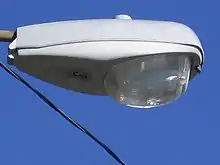 Rare 35 watt version found in Canton, Massachusetts  Rare 35 watt full cutoff version found in Westwood, Massachusetts |
A small cobra head, replaced the L150, predecessor to the OVZ. | ||
OVM (150–400 watts)
 |
A medium cobra head, replaced the L250, predecessor to the OVD. | ||
OVG (50–250 watts)
  Rare 35 watt version found in Canton, Massachusetts |
A Small cobra head, semicutoff and cutoff version of OVH, smaller version of the OVD and OVY. | ||
OVH (50–250 watts)
 |
A Small cobra head, fullcutoff version of the OVG, smaller version of the OVF. Also available with LED lighting. | ||
OVD (150–400 watts)
 |
A medium cobra head, Semicutoff fixture, replaced the OVM, this fixture uses the same glass that also appears on the Westinghouse OV-25 Silverliners, OVM and L250, it is the larger version of the OVG. | ||
OVY (150–400 watts)
  Rare 70 watt version found in West Roxbury, Boston, Massachusetts, date October 4, 2008. |
A medium cobra head, the cutoff version of the OVD, it is the larger version of the OVG | ||
OVF (150–400 watts)
  LED Retrofit at Dedham Corp/128 Commuter Rail Station. |
A medium cobra head, the fullcutoff version of the OVD, it is the larger version of the OVH. Also available with LED lighting. | ||
OVX (50–400 watts)
 |
A small cobra head available in semicutoff or fullcutoff, the OVX was not a direct replacement for any other model, it is slightly controversial in that it is a small cobra head that has the option for medium-sized lamps often causing shorter lamp life. | ||
OVZ (50–250 watts)
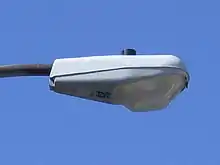 |
A small cobra head available in semicutoff or fullcutoff, replaced the OVS. | ||
OVC (50–250 watts)
  Rare 35 watt version found in Canton. Massachusetts  Rare 35 watt full cutoff version found in Westwood, Massachusetts |
Same as the OVZ except unpainted was used in the Canadian market, however Canada now uses the OVZ. | ||
| RMA/RMC | NEMA head luminaire. | ||
| VAN Vanguard III | NEMA head luminaire. | ||
| LPC | |||
| HMX | High Mast luminaire. | ||
VERD Verdeon
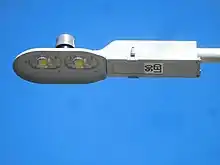 |
Small LED luminaire, equivalent to 50-250 watt HPS. | ||
VERD-M Verdeon
 |
Medium LED luminaire, equivalent to 400-1000 watt HPS. | ||
NVN Navion
 |
Medium LED luminaire, equivalent to 150-400 watt HPS. | ||
XNV
  dayburner |
Large LED luminaire, equivalent to 400-1000 watt HPS. | ||
| VTS | LED | ||
CRTK (48 watts)
  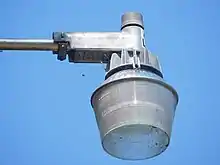 |
Small LED Luminaire. It can have 3 different refractor options. These were found in Taunton, Raynham, and Middleborough, Massachusetts | ||
| CRTK2 | LED | ||
| XNV2 | Same as the NVN Navion. | ||
ARCH Archeon (20-70 watts)
 70 watt version  40 watt version |
LED cobra head luminaire. | ||
| CST Celesteon (234-760 watts) | LED high mast lighting, perfect for highways and large areas | ||
Cree | |||
XSPR (25-54 watts)
 25 watt version found in Winchester, Massachusetts  44 watt high output version found in Somerville, Massachusetts  54 watt high output version found in Canton, Massachusetts |
Small LED fixture. Equivalent to 50-100 watt HPS. | ||
XSP1 (50-101 watts)
 |
Medium LED fixture. Equivalent to 50-150 watt HPS. | ||
XSP2 (101-168 watts)
 |
Large LED fixture. Equivalent to 150-400 watt HPS. | ||
| Traveyo Series (17-219 Watts) | Small, medium and large LED head. | ||
| RUL Series (50 watts) | Cree LED NEMA head. | ||
RSW (20-136 watts)
 50 watt version found in Newburyport, MA  20 watt version found in Whitman, MA  50 watt version found in Whitman, MA  80 watt version found in Whitman, MA |
Small LED fixture. Equivalent to 150-400 watt HPS. | ||
OSQ Series (53-215 Watts)
 Brown version  Gray version found in Whitman, MA |
Decorative LED street light. | ||
| XSP Series (47-184 watts) | |||
Cree Edge high output (267-831 watts)
 |
Cree's High mast lighting. | ||
Cree Edge (25-263 watts)
 |
architectural LED post top and arm fixture. | ||
LEDway (100-155 watts)
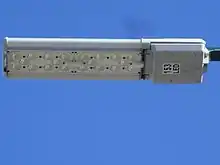 153 watt version found in Everett, MA |
Medium LED fixture. Equivalent to 150-400 watt HPS. | ||
E-Lite | |||
Star SL3S (30–160 watts)
 30 watt version  110 watt version  160 watt version |
LED Street light introduced in 2017. Found in Stoughton, Massachusetts | ||
Everlight Electronics | |||
SL-Dolphin (50–150 watts)
 SL-Dolphin found in the parking lot of Blanchard's in Jamaica Plain, Boston, MA |
LED Street light introduced in 2010. | ||
General Electric | |||
| Form 175 (100–250 watts) | Predecessor to the M250. Had the strange cone shaped refractor. (Very Rare!) | ||
Form 109 (250–400 watts)
 |
Predecessor to the Form 400.held 600 watt incandescent lamps or 400 watt mercury vapor lamps.made from 1948 to 1955. | ||
Form 400 (250–400 watts)
  Form 400 Power Pack |
Replaced the Form 109, and predecessor to the M400.also made as the form 400 powerpack an iteragate ballast version of the form 400. made from 1956 to 1959. | ||
| Form 402 (700–1000 watts) | Predecessor to the M1000. | ||
| Form 7980 | Claw shaped fixture. Similar to the Boston Wheeler crescent moon heads. | ||
| Form 131VR | Predecessor to the Form 79RV | ||
| Form 72 | Predecessor to the Form 79 luminaire | ||
| Form 45113 | Pendant or span wire mount luminaire for incandescent lamps (extremely rare!) | ||
| Form 110 luminaire | "Compact" luminaire. uses mercury vapor lamps or incandescent lamps. Also includes photocell. | ||
201-SA (70-150 watts HPS and Metal Halide) 100w Metal Halide found in Billings MT |
Current General Electric NEMA luminaire first introduced in the early to mid-1980s as the Form 201 and redesigned and renamed in 1985, and again slightly redesigned in the late 1990s-early 2000s. The newer 201SA fixtures no longer feature a gray paint, and come standard with stainless aluminum, and a tool-less photoelectric socket, meaning the technician does not require any tools to adjust the photoelectric socket. As of 2008, Mercury Vapor is no longer offered. (Example: SAH10S1N21181 utility model) | ||
| PMA-115/PMC-116/PMC-117 (50-175 watts) | GE's Post-Top Luminaire. Compatible with either mercury vapor or high-pressure sodium. A major difference is that the PMA-115 uses a flat top design, while the similar PMC-116 has a cone-shaped design. The PMC-117 series is the same as the PMC-116 but with added decorative scrolls. | ||
| P16M/P17M (50-175 watts) | GE's Post-Top Luminaire. Competes with American Electric's 245 Contempo Series Luminaires, and 247 American Revolution Series Luminaires. The P16M is the P17M but with added decorative scrolls. These models replaced GE's PMC-116 and PMC-117 post-top luminaires. Discontinued in 2016 in favor of GE's LED Luminaires | ||
| M100 (100–175 watts) | An open bottom companion to the M250, also believed to be the first as a full cutoff. | ||
M150 (50–250 watts)
 semi-cutoff version  full cutoff version |
This PowrDoor luminaire, noted for its boxy profile, was introduced in 1980 as a companion to the M250A. In 1986, it was renamed the M250A2, and continues to use that designation today. | ||
M250 (1959–1960)/M250R (1960–1970)M250R1 (1970–1985)/M250R2 (1985–present) (50–250 watts)
 M250R  M250R1 dayburner .jpg.webp) M250R2 |
Introduced in 1959, redesigned in smaller body in 1960 then redesigned in May 1970 (as the M250R1) and 1985 (as the M250R2). The original M250 from 1959 to 1960 was actually a fixture with a M-400 body but with plastic refractor. Additionally, "Crimefighter" versions of the M250R exist in Chicago, with a cylinder-shaped refractor attached to the 1970 version's bodyshell. In 1993, GE Experimented with a slightly re-designed body for the M250R2, but reverted to the current version from 1994–Present. (Example: M2RR25S0A2GMS3358 | ||
M250A (1967–1985)/M250A2 (1986–present) (50–250 watts)
 M250A  M250A1  M250A2 |
This PowrDoor luminaire was introduced in 1967 as the smaller companion to the M400A, and its bodyshell was a miniature version of the M400A's. A full-cutoff version of this luminaire was introduced in around 1980 (very rare!). It was redesigned in 1986, taking on the M150's boxy profile, and renamed the M250A2. ARK Lighting's A601 and A604 luminaires use the same designs as these luminaires, but with notable differences: The A601 (which is similar to the M250A2) uses lamp sizes of up to 250 watts, and the A604 (which is similar to the original M250A) uses lamp sizes of up to 400 watts. | ||
M400 (1959–1970)/M400 Split-Door (1970-1985)/M400R2 (1986–1996 Reintroduced in 2008–2016) /M400R3 (1997–present) (150–400 watts)
 1959 version, dayburner  1960s version with different thumb latch  1960s gray version  M400 Split-Door  M400R2  M400R3 |
Introduced in 1959, this single-door luminaire was discontinued around 1970. From 1970 to 1986, the split-door M-400 was virtually identical to the M-400A with the exception of having a non-vented door held in place with a simple spring latch. The ballast components were mounted on the top housing. In 1986, it was revived as the M400R2, with a TuDor-esque flat profile to distinguish it from the M400A2 PowrDoor. The current version (introduced in 1997 as the M400R3) looks similar to a Thomas/Betts 125 except for a slightly bulkier housing and a bail-type latch. | ||
M400A (1967–1985)/M400A2 (1986–1996 Reintroduced in 2008–2016) /M400A3 (1997–present) (150–400 watts)
 M400A PowrDoor  M400A1 Full-Cutoff 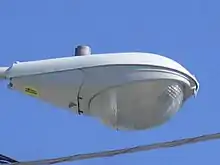 M400A2  M400A3  M400A3. Rare 100 watt version found on the Tobin Bridge in Chelsea, Massachusetts |
This PowrDoor luminaire was introduced in 1967 as the larger companion to the M250A. Earlier versions had a vented door held in place with a more complex bail latch. A full-cutoff version of this luminaire was introduced in 1975. In 1986, it was renamed the M400A2 (this incarnation did not have the vented door of the earlier models), with the arrival of the single-door M400R2. The current version (introduced in 1997 as the M400A3) looks similar to a Thomas/Betts 325 except for a slightly bulkier housing and a bail-type latch. From 2008 until 2016, both the M400A2 and M400A3 were in concurrent production.
There are rare 100 watt versions of the M400A3 that exist on the Tobin Bridge in Chelsea, Massachusetts. Additionally, "Crimefighter" versions exist in Chicago, with a bucket-shaped refractor attached to the normal 1975 full-cutoff version's bodyshell. | ||
M1000 (700–1000 watts)
 Finned version with photocell on the fin 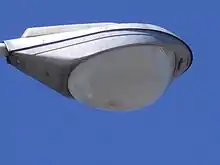 Finned version sans photocell  1960s redesign 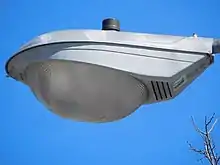 1978-1987 redesign |
Introduced in 1959, adopted fins until the mid-1960s, was redesigned in 1978, and discontinued around 1987. | ||
GE Evolve | |||
ERLC series (23-43 watts)
 23 watt version  43 watt version |
GE's newest compact (30% smaller than ERL1) cobra head that utilizes LED lighting with easy install, miniature ERL1 series (50-100 watt equivalent). | ||
ERL Series (15–200 watts)
 Evolve ERL1  Evolve ERL1 - 15 watt version found in Watertown, Massachusetts  Evolve ERL2 - 120 watt version found on Route 138 in Taunton, Massachusetts |
GE's newest medium and large cobra head that utilizes LED lighting, Replaced ERS series. | ||
ERS series (15-200 watts) Evolve ERS3 Scalable - Gray version found in Stoughton, Massachusetts 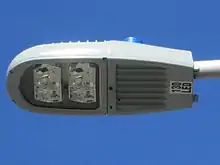 Evolve ERS2 Scalable - Gray version found in Stoughton, Massachusetts  Evolve ERS2 Scalable - Gray version found in Raynham & Taunton, Massachusetts  Evolve ERS2 Scalable - Black version found in Wakefield, Massachusetts  Evolve ERS2 Scalable - Black version, dayburner found in the parking lot of 7-Eleven in Quincy, Massachusetts  Evolve ERS1 Scalable - Black version found in Wakefield, Massachusetts |
GE's small, medium and large cobra head that utilizes LED lighting, This luminaire is designed to eventually replace the M250R2 and M400R3 luminaires. New Evolve LED luminaires are in development to replace the PF400 and PF154 PowrFlood models. HPS. | ||
Evolve LED Flood Light - EFH1
 EFH1 Flood Light found in Raynham and Taunton, Massachusetts |
GE's newest Flood Light that utilizes LED lighting. | ||
| Evolve High Mast - ERHM | GE's newest high mast lighting that utilizes LED lighting, perfect for highways and large areas. | ||
Evolve EPST
 Evolve EPST - Found in Brockton, MA |
GE's newest post top that utilizes LED lighting. Traditional style. | ||
| Evolve EPTC | GE's newest post top that utilizes LED lighting. Contemporary style. | ||
| Evolve Avery StreetDreams - EPAS | GE's newest post top that utilizes LED lighting. Vintage style. | ||
Howard Lighting | |||
USC3 (50–250 watts)
 USC3 version  USC3-LED version |
Available in High Pressure Sodium (USC3) and LED (USC-LED). And available in black or gray finishes. | ||
L400 (25-240 watts)
Hubbell | |||
RM-series (50–250 watts)
 RMG semi cutoff  RMC full cutoff  LED Retrofit found on Snug Harbor Court in Quincy, Massachusetts |
The smaller companion to the RL-series. | ||
RL-series (200–400 watts)
 RLG semi-cutoff  RLC full cutoff  LED retrofit at Boston Public Health Commission in Mattapan |
The larger companion to the RM-series, its look bears a resemblance to a Thomas & Betts Model 25. | ||
| RK-series (400–1000 watts) | The largest of all Hubbell streetlights. | ||
Joslyn Mfg. and Supply | |||
| MV111 (100–250 watts) | Remote-ballasted fixture, the smaller companion to the MV131. The "MV" designation is said to stand for "Mercury Vapor," and the majority of all Joslyn luminaires still use mercury lights. | ||
MV121 (100–250 watts)
 MV121 with wireguard from Kennedy School in Brockton, MA |
The smaller companion to the MV141. It looks like a spaceship with a refractor stuck underneath. | ||
| MV131 (250–400 watts) | Remote-ballasted fixture, the larger companion to the MV111. | ||
MV141 (250–400 watts)
 |
The larger companion to the MV121. | ||
| MV151 (400–1000 watts) | The largest companion of all the Joslyn streetlamps. | ||
King Luminaire | |||
K805 (250-400 watts)
  LED version |
Pendant style luminaire. | ||
K708
 |
Pendant style luminaire. | ||
K201
 |
Pendant style luminaire. | ||
K204
 |
Pendant style luminaire. | ||
K205
 |
Pendant style luminaire. | ||
K282
  |
Pendant style luminaire. | ||
K309
 |
Pendant style luminaire. | ||
K728
 |
Pendant style luminaire. | ||
K803
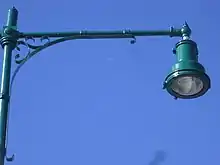 |
Pendant style luminaire. | ||
K808
 |
Pendant style luminaire found in New York, New York. | ||
K811
 |
Pendant style luminaire. | ||
K118
 |
Post top luminaire. | ||
LED Roadway | |||
NXT (20-100 watts)
 |
Small LED fixture, equivalent to 100-250 watt HPS. | ||
NXT (50-200 watts)
 |
Medium LED fixture, equivalent to 250-400 watt HPS. | ||
48 Satellite Series (50-200 watts)
   |
Small & Medium LED fixtures, equivalent to 100-250 & 250-400 watt HPS. | ||
Leotek | |||
Arieta (40-150 watts)
 AR13 |
Smaller version of the AR18. | ||
Arieta (60-180 watts)
 AR18 |
Grey version. | ||
Arieta (60-180 watts)
 AR18 |
Black version. | ||
E-Cobra (19-80 watts)
 EC2 |
Small LED luminaire. | ||
E-Cobra (50-130 watts)
 EC4 |
LED luminaire. | ||
E-Cobra (40-190 watts)
 EC7 |
LED luminaire. | ||
GCJ (15-68 watts)
 |
Small LED fixture, equivalent to 35-150 watt HPS. | ||
GCM (58-138 watts)
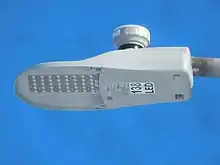 |
Medium LED fixture, equivalent to 150-250 watt HPS. | ||
GCM (58-138 watts)
 |
Painted green on the Neponset River Bridge in Quincy/Boston, Massachusetts. | ||
GCL (105-192 watts)
 135 watt version  185 watt version |
Large LED fixture, equivalent to 250-400 watt HPS. | ||
GC1 (24-150 watts)
 |
Small LED fixture, equivalent to 200-400 watt HPS. | ||
GC2 (120-240 watts)
  310 watt version found in Chelsea, Massachusetts |
Medium LED fixture, equivalent to 310-400 watt HPS. | ||
Lithonia Lighting | |||
| TDS2 | Lithonia's model # for the Durastar 2000. | ||
| TDS3 | Lithonia's model # for the Durastar 3000. | ||
| CHE | Same as the American Electric Lighting Roadway 413 luminaire. | ||
| CHL | Same as the AEL Roadway 115. | ||
| CHLD | Same as the AEL Roadway 315. | ||
| CHM | Same as the AEL Roadway 125. | ||
| CHMD | Same as the AEL Roadway 325. | ||
| CHX | Same as the AEL Roadway 327. | ||
| TMM | Same as the AEL Multi-Mount 285. | ||
| TDR | Same as the AEL Interstate II series 775. | ||
| TSL | Same as the AEL Signlite 875. | ||
| D-Series MA Area | LED cobra head | ||
| D-Series Area Size 0 | LED small area light | ||
D-Series Area Size 1
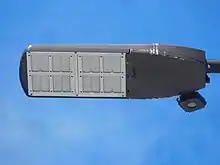 |
LED medium area light | ||
| D-Series Area Size 2 | LED large area light | ||
| KAD-LED | LED shoe box light | ||
| KAD | shoe box light | ||
| RSX1 | LED Area Luminaire small | ||
| RSX2 | LED Area Luminaire medium | ||
| RSX3 | LED Area Luminaire large | ||
| KAX1 | LED Area Luminaire small | ||
| KAX2 | LED Area Luminaire large | ||
| AS1 | Area Luminaire | ||
| AS1-LED | LED Area Luminaire | ||
Line Material Industries/McGraw-Edison | |||
Ovalite (100–400 watts)
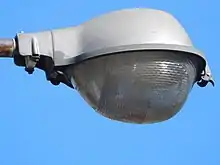 |
Remote-ballasted fixture, in the tradition of the Westinghouse OV-10/20/35 and GE Form series. The earliest Ovalite had similar style as a GE Form 109 but later it was changed and was still called an Ovalite. | ||
Unistyle 175/250 (100–250 watts)
 |
The smallest member of the Unistyle family. Most were Mercury Vapor, but there are HPS ones that exist as well. | ||
Unistyle 400 (250–400 watts)
  Mercury Vapor dayburner found in Hyde Park, Boston, Massachusetts  High Pressure Sodium Dayburner found in the Brockton Public Schools parking lot in Brockton, Massachusetts  Rare 2 door version of the Unistyle 400 found in Somerville, MA |
Most people think of the 400 as the largest member of the Unistyle family, but it's the mid-sized fixture. Most were Mercury Vapor, but there are HPS ones that exist as well. | ||
| Unistyle 1000 (700–1000 watts) | This very rare fixture was the largest member of the Unistyle family. | ||
Unidoor 175/250 (100–250 watts)
 Silver version by Line Materials Industries found in Peabody, Massachusetts  Gray version by McGraw-Edison found in Boston, Massachusetts |
Replaced the Unistyle 175/250 and designed for HPS lights, although some also used Mercury Vapor lights | ||
Unidoor 400 (200–400 watts)
 Silver version by Line Materials Industries, found in Peabody, Massachusetts |
Replaced the Unistyle 400 and designed for HPS lights, although some also used Mercury Vapor lights | ||
| Unipost 175 (50-175 watts) | Post-top luminaire that can use mercury vapor or HPS lamps. | ||
| Spherolite (50-295 watts) | Pendant type luminaire. Uses incandescent or mercury vapor lamps. | ||
| Suburbanaire (50-295 watts) | "NEMA HEAD" style yard light for incandescent or mercury vapor lamps. Dates back to 1963 | ||
| Resilite (100-175 watts) | "NEMA HEAD" style light for mercury vapor lamps. | ||
| Dusk-To-Dawner (100, 175, & 250 watts) | Dusk to dawn cobrahead security light for mercury vapor lamps. | ||
| Traditionaire (100, 150 & 175 watts) | Post-top luminaire that can use mercury vapor, HPS or metal halide lamps. | ||
LUMINOS | |||
| H-08 | Induction fixture | ||
| LED Highway | Medium and large LED fixture | ||
| LED Residential (40-80 watts) | small LED fixture | ||
Pemco | |||
Brightway Jr. (50-250 watts)
 |
A snall rare cobrahead luminaire | ||
Philips Hadco (Signify) | |||
RX1 (70-110 watts)
 70 watts LED  110 watts LED |
A small LED street light found in Boston, Massachusetts. Introduced in June 2011. | ||
RX2 (200-270 watts)
 270 watts LED  200 watts LED |
A medium LED street light found in Boston, Massachusetts. Introduced in June 2011. | ||
Philips Lumec | |||
RFL
 220 watt RFL - found in Boston, MA |
RoadFocus LED Medium | ||
RFM
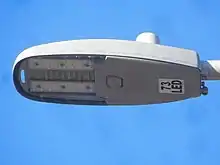 73 watt RFM - found in Hingham, MA  106 watt RFM - found in Hingham, MA 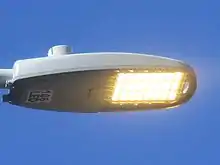 106 watt RFM dayburner - found in Hingham, MA |
RoadFocus LED Medium | ||
RFS
 38 watt RFS - found in Hingham, MA |
RoadFocus LED Small | ||
Powerlite Devices | |||
| B2217 (100-250 watts) | The first small Powerlite fixture designed in the 1960s, this design was the smallest of the first generation or Powerlite fixtures, all used mercury vapor lamps however some remain in High Pressure Sodium | ||
| B2215 (400 watts) | The medium-sized fixture in the first generation series, the B2215 could accommodate up to 400 watt mercury vapour lamps. | ||
| B2213 (700-1000 watts) | The B2213 was the largest of the first generation and is the largest cobra head style fixture ever made, at more than 4 feet in length. | ||
| B2227 * Later known as the R37* (50-250 watts) | The B2227 was the small fixture in the second generation of Powerlite fixtures, introduced in the late 1970s it was shorter than the B2217. Many B2227s where equipped with High Pressure Sodium which replaced less efficient mercury vapor lamps. | ||
B2255 (200-400 watts)
 |
The B2255 was the medium-sized fixture in the second generation series, it was commonly used with 200-400 watt High Pressure Sodium lamps. The B2225 was introduced in the 1970s and was manufactured until the early 1990s. The B2255 was the only fixture that had the option on a power door, where the ballast and other electrical components are mounted on a second door on the fixture, allowing for quick repairs. | ||
| B2228 (1000 watts) | The B2228 used the same housing as the B2255 and featured the same features, however it used a larger reflector inside the fixture to house the larger 1 kW lamps. | ||
R47 (50-400 watts)
 full cutoff version found on the Tobin Bridge in Chelsea, Massachusetts |
The R47 was released in 1992 and would end up being one of Powerlite's last designs produced until the company's merger in 2002. The R47 was a small fixture that was about the same size as the B2227 and used the same refractor footprint, it however, was able to accommodate up to 400 watt High Pressure Sodium lamps. | ||
R7 (50-400 watts)
 |
The R7 "Roadkat" was the final Powerlite design created in 1996, this fixture feature a more modern slipfitter design and compact size, this fixture still continued to use the same refractor foot print shared by the R47 and R37 (B2227) which is also shared by most small GE, AEL and Cooper Lighting fixtures still made to this day. | ||
| Twistpak (50-250 watts) | The Twistpak was a post top fixture manufactured from the 1970s onward, the Twistpak use a modular design, where the ballast and all electrical components where mounted on a tray for quick change out if needed, the top refractor would twist off (hence the name) to allow access to the lamp and ballast. There was also a pole integrated version where the ballast was mounted inside the pole and the refractor assembly would mount directly to the top of the pole. The Twistpak design is still manufactured by American Electric Lighting. | ||
RAB | |||
TRIBORO
 Triboro found in the parking lot of George Wright Golf Course in Hyde Park, Boston, Massachusetts. |
Small and medium LED cobra head. | ||
| TRIBORO XL | Large LED luminaire. | ||
LROAD LROAD on Franklin Plaza, corner of Granite Street and Franklin Street, Braintree, Massachusetts |
Small and medium LED luminaire. | ||
| IVELOT | Low profile, low glare. Edge-lit technology unlike any other. 117W - 38W | ||
| ALED | Specification Grade Area lights available in IES Type II, III and IV distributions. For use in parking lots, roadways, pathways and general area lighting. 360w - 50w | ||
| ALED 5s & 5T | High output LED pole top area light | ||
| LOTBLASTER | Specification grade area lights available in IES Type II, III, IV and VS distributions. For use in parking lots, roadways, pathways and general area lighting. 160W - 65W | ||
YBLED Found in Middleboro, MA |
High output LED yardblaster delivers enough light to hit the broad side of a barn. Durable finish withstands harsh environments. 60W - 26W | ||
Revere | |||
Revere 400 (250–400 watts)
 |
Resembles a Westinghouse OV-25 Silverliner, but uses an M400-style refractor. | ||
Revere 1000 (700–1000 watts)
 |
Resembles a Westinghouse OV-50 Silverliner, but with a shorter neck. | ||
US Lighting Group | |||
Tech CO1 (40-150 watts)
 Tech CO1 40 watt version  Tech CO1 150 watt version  Tech CO1 150 watt dayburner  Jersey Series |
Induction lamp street light found in Lexington, Massachusetts. Note the "I" on the Nema tag means "Induction". | ||
Visionaire Lighting | |||
Element II (28-76 watts)
  |
LED street light found in Dedham, Massachusetts. | ||
Roadway LX (36–133 watts)
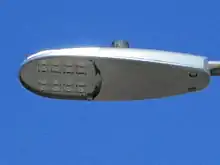   |
LED street light found in Dedham, Massachusetts. | ||
| BOW Roadway | LED arm mount street light | ||
| Oden Roadway | Decorative arm mount street light | ||
| Mission Bell | Decorative LED arm mount street light | ||
Westinghouse | |||
| AK-10 | Incandescent gumball or deep bowl teardrop luminaire | ||
OV-10 (100–250 watts)
 |
Predecessor to the OV-12. | ||
OV-20 (250–400 watts) |
Predecessor to the OV-25. | ||
| HMA-60 (700–1000 watts) | Companion model to the OV-20 | ||
OV-35 (700–1000 watts)
 |
Predecessor to the OV-50. | ||
| MO-8 (100–175 watts) | A flat-bottomed Silverliner in a cobrahead style with internal reflector, believed to be the Westinghouse full-cutoff fixture. Ballast and slipfitter is accessed by simply unscrewing a stainless screw on the top and the top "folds open" revealing a ballast and slipfitter found on the bottom casing. | ||
| MO-9 (100–175 watts) | A flat bottomed Silverliner with an external stamped reflector and a ballast casing attached. | ||
OV-12 (100–250 watts)
 |
Replaced the OV-10, predecessor to the OV-15. Introduced in 1960. This fixture looks like a shrunken-down OV-50. | ||
| OV-14B (100–250 watts) | Replaced the OV-10, predecessor to the OV-15. Introduced in 1957. It looks like a smaller version of the 1957 design of OV-25. Also those were mostly used in Canada when the United States had the OV-12 but the OV-14B can be found in the USA but is quite rare. | ||
OV-15 (50–250 watts)
  4th generation, later becoming the Crouse-Hinds L-150 |
Replaced the OV-12 and OV-14B as the smallest Silverliner. Introduced in 1965 and redesigned in 1979. This was also modified in the early 1970s to use HPS lamps as well as mercury vapor. The Crouse-Hinds L150 was originally designated as an OV-15. This fixture continued Canadian production as the Cooper OV-15 most likely until around the time that Powerlite merged with American Electric. | ||
| OV-15 TuDor (50–250 watts) | Introduced in 1970, this split-door luminaire featured a flatter profile and was designed to compete directly with the General Electric M250A Powr/Door luminaire and was Westinghouse's first HPS fixture as the regular single door OV-15 weren't modified for HPS use yet; however, some mercury vapor versions also exist. | ||
OV-25 (250–400 watts)
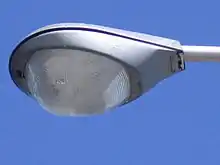 Remote-ballasted OV25  Original 1957 version  Early 1960s version  1960s redesign  4th generation, later becoming the Crouse-Hinds L-250. Note: Most of these luminaires in Boston, Massachusetts, were retrofitted for high-pressure sodium lamps, though there used to be two of these on Metropolitan Avenue in Hyde Park that had mercury vapor lamps |
Mid-sized Silverliner, and the most common streetlight fixture in North America. Introduced in 1957, redesigned in 1964 and again in 1979. This is believed to be the first-ever integral-ballasted fixture. A remote-ballasted version was also available, with a truncated back as its most notable feature. This was also modified in the early 1970s to use HPS lamps as well was mercury vapor. The Crouse-Hinds L250 was originally designated as an OV-25. This fixture continued U.S. production as the Cooper OVW, and it also continued Canadian production as the Cooper OV-25 most likely until around the time Powerlite merged with American Electric. | ||
OV-25 TuDor (250–400 watts)
 |
Introduced in 1970, this split-door luminaire featured a flatter profile and was designed to compete directly with the General Electric M400A Powr/Door luminaire. This was also Westinghouse's first HPS fixture as the regular single door OV-25 weren't modified for HPS use yet; however, some mercury vapor versions also exist. | ||
OV-50 (700–1000 watts) OV50 with fin  OV50 sans fin |
The largest Silverliner, introduced in 1963. Adopted fins in the mid-1960s. This was also modified in the early 1970s to use HPS lamps as well was mercury vapor. This fixture continued U.S. production as the Cooper OVL, and it also continued Canadian production as the Cooper OV-50 most likely until the around late 2000s/early 2010s. | ||
Wheeler Boston | |||
Crescent Moon
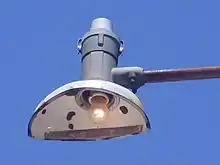 Crescent Moon, Dayburner 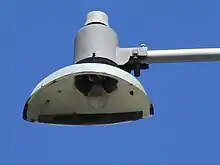 Crescent Moon, Smaller version |
Crescent Moon. | ||
Radial Wave
 Incandescent luminaire |
Radial Wave. | ||
Conical Glass Style Fixture
 Mercury Vapor luminaire |
Conical Glass Style Fixture. | ||
See also
References
- "NEWPORT FIRSTS". Newsroom.discovernewport.org. Retrieved 9 February 2015.
- "Encyclopedia of Cleveland History". 18 June 2018. "Cleveland was the First City of Light"
- "Wabash, IN - First Electrically Lighted City in the World". Roadsideamerica.com. 2005-06-14. Retrieved 2015-04-30.
- "Archived copy" (PDF). Archived from the original (PDF) on 2012-01-09. Retrieved 2011-11-29.CS1 maint: archived copy as title (link)
- "Municipio de Linares Nuevo León". Archived from the original on August 3, 2012. Retrieved December 24, 2011.
- "Archived copy". Archived from the original on 2012-04-26. Retrieved 2011-12-24.CS1 maint: archived copy as title (link)
- "Archived copy" (PDF). Archived from the original (PDF) on 2011-07-23. Retrieved 2009-06-03.CS1 maint: archived copy as title (link)
- "Archived copy". Archived from the original on 2011-07-17. Retrieved 2009-06-03.CS1 maint: archived copy as title (link)
- "L.A. Mayor meets with Clinton on city light plan | L.A. NOW | Los Angeles Times". Latimesblogs.latimes.com. 2009-02-15. Retrieved 2015-04-30.
- "Seattle City Light News Release Detail: Seattle City Light Begins LED Streetlight Rollout". Seattle.gov. 2010-07-07. Retrieved 2015-04-30.
- "Frangioso's Street Lighting Gallery". Frangioso's Street Lighting Gallery.
External links
- Frangioso's Street Lighting Gallery David Frangioso's website showcasing street lights in the Boston area of Massachusetts.
- Lighting-Gallery.net A community site where users can upload lighting pictures.
